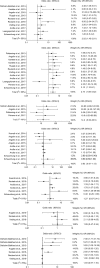Acquisition of multidrug-resistant Enterobacterales during international travel: a systematic review of clinical and microbiological characteristics and meta-analyses of risk factors
- PMID: 32434591
- PMCID: PMC7237615
- DOI: 10.1186/s13756-020-00733-6
Acquisition of multidrug-resistant Enterobacterales during international travel: a systematic review of clinical and microbiological characteristics and meta-analyses of risk factors
Abstract
Background: International tourism increased from 25 million tourist arrivals in 1950 to over 1.3 billion in 2017. These travelers can be exposed to (multi) resistant microorganisms, may become colonized, and bring them back home. This systematic review aims to identify the carriage rates of multidrug-resistant Enterobacterales (MDR-E) among returning travelers, to identify microbiological methods used, and to identify the leading risk factors for acquiring MDR-E during international travel.
Methods: Articles related to our research question were identified through a literature search in multiple databases (until June 18, 2019) - Embase, Medline Ovid, Cochrane, Scopus, Cinahl, Web of Science, and Google Scholar.
Results: Out of 3211 potentially relevant articles, we included 22 studies in the systematic review, and 12 studies in 7 random-effects meta-analyses. Highest carriage rates of MDR-E were observed after travel to Southern Asia (median 71%), followed by travel to Northern Africa (median 42%). Carbapenemase-producing Enterobacterales (CPE) were identified in 5 out of 22 studies, from a few patients. However, in only eight out of 22 studies (36.4%) the initial laboratory method targeted detection of the presence of CPE in the original samples. The risk factor with the highest pooled odds ratio (OR) for MDR-E was travel to Southern Asia (pooled OR = 14.16, 95% confidence interval [CI] = 5.50 to 36.45), followed by antibiotic use during travel (pooled OR = 2.78, 95% CI = 1.76 to 4.39).
Conclusions: Risk of acquiring MDR-E while travelling increases depending on travel destination and if antibiotics are used during travel. This information is useful for the development of guidelines for healthcare facilities with low MDR-E prevalence rates to prevent admission of carriers without appropriate measures. The impact of such guidelines should be assessed.
Keywords: Antimicrobial resistance; Beta-lactamases; Enterobacterales; Enterobacteriaceae; Epidemiology; Meta-analysis; Microbiology; Systematic review; Travel.
Conflict of interest statement
AFV, KM, BB, AS, AV, MV and JS declare that they have no competing interests. JS recently collaborated with employees of bioMérieux on a research project that included whole-genome sequencing of bacterial isolates, which was performed by the company.
Figures


References
-
- World Health Organization. Antimicrobial resistance: global report on surveillance. 2014.
-
- Magiorakos AP, Srinivasan A, Carey RB, Carmeli Y, Falagas ME, Giske CG, et al. Multidrug-resistant, extensively drug-resistant and pandrug-resistant bacteria: an international expert proposal for interim standard definitions for acquired resistance. Clin Microbiol Infect. 2012;18(3):268–281. - PubMed
-
- Schwaber MJ, Carmeli Y. Mortality and delay in effective therapy associated with extended-spectrum beta-lactamase production in Enterobacteriaceae bacteraemia: a systematic review and meta-analysis. J Antimicrob Chemother. 2007;60(5):913–920. - PubMed
-
- Karanika S, Karantanos T, Arvanitis M, Grigoras C, Mylonakis E. Fecal colonization with extended-spectrum Beta-lactamase-producing Enterobacteriaceae and risk factors among healthy individuals: A systematic review and Metaanalysis. Clin Infect Dis. 2016;63(3):310–318. - PubMed
Publication types
MeSH terms
Substances
LinkOut - more resources
Full Text Sources
Research Materials
Miscellaneous

